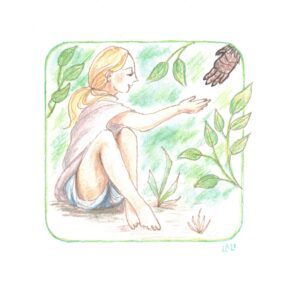They were long and smooth and toasted a honey color by the African sun. They carried Jane up trees and down ravines, and the vipers, adders, and black spitting cobras of Gombe would move aside respectfully when those twin golden columns came their way. Before she became a major figure in the field of ethology, Jane Goodall’s looks got almost as much attention as her mind. Newspaper headlines called her “comely,” and “pert,” and “beautiful.” But it was her legs, emerging lithe and bare from her khaki shorts, that embodied the seemingly opposite qualities that defined her: intrepid determination and feminine vulnerability.
Near the end of her life Jane recalled how, in 1965, when she made the cover of the National Geographic for the first time, envious colleagues muttered that the only reason she had been featured was because of her elegant legs. “But I didn’t care,” said the elderly Jane. “If my legs helped to fund my research, more power to them.” Most women over sixty today will recognize that pact with the devil. Things were so stacked up against us that we had to use whatever weapons we had at our disposal.
Unfortunately, beauty was a two-sided sword. On the one hand, good looks could help you get what you wanted. If you weren’t at least moderately attractive, you were out of luck. I recall sitting as the lone woman on the admissions committee of the college where I taught while applications, which in those days featured photos, were being passed around. We were debating the merits of a certain candidate when one of the faculty at the table said, “Let’s not take her. She’s too fat.” There is no question that if Jane Goodall had been cursed with “piano legs,” her discoveries of tool-use among chimpanzees, their tendencies towards both gentleness and violence, their love of meat and warfare, might have taken longer to become known around the world. But she was charming, had good hair as well as good legs—her blond pony tail made a nice contrast against the chimps’ dark fur—and was highly photogenic, and those traits served her well. (It also helped that she was married to the wildlife photographer Hugo van Lawick.)
On the other hand, while her looks got her plenty of attention and helped to garner the funds that she needed to continue her work at Gombe, did she ever wonder if those envious colleagues were right? Did she occasionally suffer from Pretty Girl Impostor Syndrome? She had, after all, only a secretarial degree to her credit when she went to Africa and began her research. As she spent weeks and months in blistering heat and torrential rains watching and recording the minute details of chimpanzee life, did she ever lose confidence in her ability to interpret those mountains of data? When she walked into a room of fellow scientists to defend her research, did she wonder if they only thought of her as the girl with the good legs? And when she became, before age thirty, famous all over the planet, did she ever question if she truly deserved the accolades?
Fortunately, she was not only a genius, but she had a combination of self-confidence and single-minded determination that allowed her to continue her work without being paralyzed by self-doubt. But millions of other women weren’t so lucky. On the one hand, looking good could help you get the scholarship, the job, or the promotion that you deserved, but on the other, the incessant focus from colleagues and bosses on your looks was sure to undermine your self confidence and make you feel that you were not worth being taken seriously.
But at last all that is over, right?
If only. While in many workplaces commenting on women’s, and men’s, physical attributes is now considered harassment, a quick look at women and girls on social media and on the streets shows that the forces that once made Jane Goodall’s legs both a help and a hindrance are still in play, and we humans are not out of the woods yet.



8 Responses
Loved your enlightening perspective, Lali, as well as your wonderful drawing!
Jane was a wonder and an icon.
We’re going backward at high speed.
I wonder how much my own weight battles affected my progress through fusion research, though I managed to be acceptable (I was brought up by a mother who had been a model and a stewardess) all the time.
Add to the stress that sometimes eating was the comfort, I had my tough times until I discovered that if I did NOT eat carbs, things were much more even-tempered.
It is hard to be surrounded by men who don’t seem to have a problem of any kind (they’re surrounded by other men, and they don’t talk about anything anyway) with energy.
I did what I had to do, and was surviving, until ME/CFS had the nerve to claim me – at a PHYSICS meeting, of all places, in 1989.
Now, after 36 years of this nonsense, I hate eating, need food every 4 hours to not pass out (yup – including 2-3 small meals in the middle of the night), and have been a stable weight for years. The things that might taste good also attack me, so it preserves life, and is incredibly boring eating.
It sounds like a complicated business, your diet, but I’m glad you’ve figured it out.
I recommend viewing a last interview given by Jane that she requested be aired only after her death. I found it on Substack.
Thank you for this, Jan. I will look it up.
Her last words (from beyond the grave) are here: https://www.youtube.com/watch?v=lfLKHY52ERc.
Absolutely luminous! Thank you for the link.